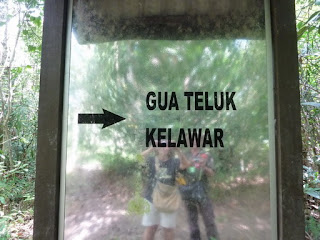Gua Teluk Kelawar is the cave where Perak Woman was found. Perak Woman is an 8000 year old skeleton, found in 2004. Perak Man was found in a nearby cave in 1991. Both caves are located in Bukit Kepala Gajah in Lenggong, Perak, Malaysia.
The Lenggong Valley was inscribed as a UNESCO World Heritage site on 30 June 2012. Before visiting the cave, we went to the Lenggong Museum. This has a feature on Gua Teluk Kelawar.
This is the entrance to the display - the name is written down the side wall
After lunch we went to see the cave. The cave is signposted from the road.
However we saw no more signs to Gua Ular (Snake Cave) so I don't know where it is or what it is and I don't think it is mentioned in any archaeological reports.
We parked at the end of the road and set off walking. At a junction we had the choice of straight or right. There was no sign. We went right. This was wrong! After quite a trek we ended up at Gua Ngaum. Wrong cave!
So we backtracked to the junction and took the other option. Walked through an orchard and came to a sign
We knew this was right as we reached the tall cliff face and this rather shabby sign
There was a small shelter and also a new rather large one
Inside the shelter is a new information board, made in the same style as those in neighbouring caves. They are very hard to read in the dark shelters, and with the reflective surface using a torch or flash doesn't help. And an army of mosquitoes soon made their presence known.
We had a good laugh when we read that reindeer were found here (!!).
Location of the cave
However there is no cave, it is just the site of a large rock shelter. There are many pits dug by the archaeologists
The cliff
See more on Perak Man.
© Liz Price
No reproduction without permission
Pictorial blogs on some of the interesting caves I have visited around Southeast Asia. On some blogs I have included photos taken over the years.
Although this blog was only born in 2011, I have now included older posts from my Multiply blog which closed in March 2013. This includes articles I have written. I am now also adding news relating to caves I have a particular interest in.
See my website on Caves of Malaysia.

sign in a cave in Laos
14 August 2012
8 August 2012
Mulu's pinnacles on Malaysian banknotes
On 8th November 2000 Malaysia introduced a new RM1 (one Ringgit) currency note - this is the lowest value of the paper money. On the back is a 'collage' of illustrations including a Malaysian kite, the beach, Mount Kinabalu and the pinnacles of Gunung Api in Mulu National Park.
The pinnacles are rather small unfortunately, located at the top right. and a close up of the pinnacles
Bank Negara Malaysia issued a new series of banknotes on 16 July 2012. Themed 'Distinctively Malaysia', the latest banknotes series draws its inspiration from the country's diverse culture, heritage and nature. The highest value note, RM100, features the pinnacles at Gunung Api, Mulu. They are next to Gunung Kinabalu in Sabah, and actually look as big as the Kinabalu mountain! Both these are World Heritage sites. and a close up
© Liz Price
No reproduction without permission
The pinnacles are rather small unfortunately, located at the top right. and a close up of the pinnacles
Bank Negara Malaysia issued a new series of banknotes on 16 July 2012. Themed 'Distinctively Malaysia', the latest banknotes series draws its inspiration from the country's diverse culture, heritage and nature. The highest value note, RM100, features the pinnacles at Gunung Api, Mulu. They are next to Gunung Kinabalu in Sabah, and actually look as big as the Kinabalu mountain! Both these are World Heritage sites. and a close up
© Liz Price
No reproduction without permission
Subscribe to:
Comments (Atom)























